Say hello to one of nature’s most dazzling little fishermen — the Common Kingfisher. With a flash of electric blue and a quick, darting dive, this bird turns an ordinary riverbank into a wildlife spectacle — just like its cousin, the White-throated Kingfisher.
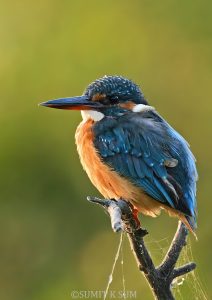
Small, shy, and incredibly fast, the Common Kingfisher is a jewel of India’s waterways. Whether you spot it perched silently on a twig or zipping low over a pond like a sapphire arrow, it’s always a delight to behold.
Identification of Common Kingfisher
This bird may be called “common,” but there’s nothing ordinary about its looks.
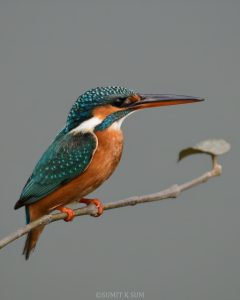
Key Identification Features:
| Size | About 16–18 cm — smaller than a sparrow, surprisingly |
| Plumage | Bright metallic blue on the back, orange underparts, and a white throat |
| Beak | Long, dagger-like, perfect for spearing fish |
| Legs | Tiny and bright red-orange |
| Call | A high-pitched ‘tsreee’ often heard as it darts past |
| Flight | Rapid, straight, and very low over water — blink and you might miss it! |
The contrast of neon blue and fiery orange makes it one of the most eye-catching birds near water bodies.
Distribution and Habitat of Common Kingfisher
The Common Kingfisher has a wide distribution, found across:
- India and the subcontinent
- Europe, North Africa, and Southeast Asia
Preferred Habitats:
- Riverbanks
- Lakes and ponds
- Canals and backwaters
- Marshy areas and mangroves
- Even city parks with clean streams or lakes
What it loves most? Clear, still or slow-moving water that’s rich in small fish — its main food source.
For more birds that thrive near Indian wetlands and forests, check out the curious Spotted Owlet and the secretive Indian Eagle Owl.
Common Kingfisher’s Behaviour and Diet
The Common Kingfisher lives a life of quiet precision and sudden bursts of action.
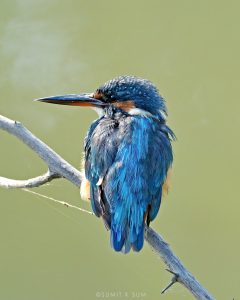
Daily Routine:
| Hunts from a low perch, watching the water below |
| Dives headfirst to snatch fish, often with breathtaking accuracy |
| Returns to the perch to beat the fish against a branch before swallowing it headfirst |
| Territorial and solitary — often defends its fishing spot from rivals |
Diet:
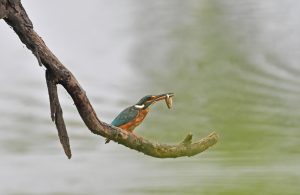
| Mostly small fish |
| Also eats aquatic insects, tadpoles, and crustaceans |
| Swallows prey whole — and regurgitates indigestible parts like bones and scales in small pellets |
A kingfisher can dive, grab a fish, and be back on its perch in less than 2 seconds!
Breeding and Nesting in Common Kingfishers
Breeding typically takes place during the warmer months — March to July in most parts of India.

Nesting Habits:
| Unlike most birds, it digs a tunnel into a riverbank or mud cliff |
| Both parents take turns excavating the nest tunnel, which can be up to 1 meter long |
| The female lays 5 to 7 white eggs |
| Both parents incubate and feed the chicks |
The nesting chamber at the end of the tunnel gets a little messy — it’s lined with fish bones and leftovers!
Common Kingfisher and Humans
Despite its shy nature, the Common Kingfisher has captured the imagination of artists, poets, and photographers for generations. They’re shy but much loved, often appearing in folklore and photography — just like the regal Indian Peafowl, which holds cultural significance across India.
They’re sensitive to water pollution and habitat loss, so their presence often indicates a healthy aquatic ecosystem. If you see a kingfisher, it means the stream or pond is likely in good shape!
Conservation Status of Common Kingfishers
The Common Kingfisher is classified as Least Concern by the IUCN, thanks to its widespread population.
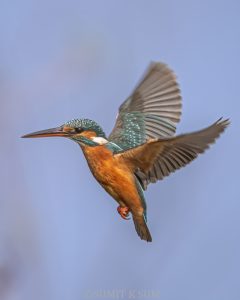
But Common Kingfishers do face threats:
| Water pollution reduces fish populations and affects its food chain |
| Habitat destruction from construction, sand mining, and deforestation |
| Climate change may affect breeding seasons and food availability |
Even though it’s not endangered, local populations are sensitive to disturbance. Conservation of clean water bodies is essential to protect them.
Fun Facts about Common Kingfishers
| Kingfishers don’t hover while fishing — they perch, observe, then dive. |
| Their vision is adapted for underwater hunting, with special transparent eyelids. |
| The vivid blue on their feathers is not pigment-based — it’s a structural color created by how light reflects. |
| Despite their bright colors, they’re hard to spot unless they move — camouflage at its finest! |
| Some cultures believe seeing a kingfisher brings good luck or a sign of calm weather. |
Want to meet another shy, ground-dwelling beauty? Don’t miss the colorful Indian Pitta — it’s as vivid as the kingfisher, but lives a very different life.
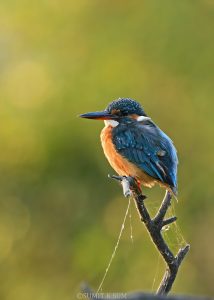
The Common Kingfisher is nature’s perfect blend of beauty and precision. Dressed in bright blue and orange, it zips through wetlands like a living gem. Whether you’re a seasoned birder or just someone who enjoys the serenity of a lakeside walk, spotting a kingfisher always feels like finding a treasure.
So next time you’re near a stream, stay still, keep your eyes on the reeds — and you just might catch a glimpse of this little blue hunter at work.
Explore more stunning birds in our Birds of India section.
| Get your favourite Common Kingfisher photograph framed for your wall – Request Now @+91-9540178459 |
